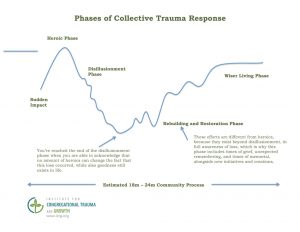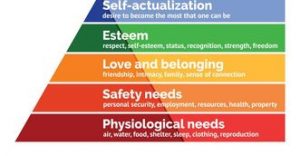5 Ways to Help Your Daughter Through Teen Depression
Depression, or Major Depressive Disorder as it’s diagnosed, is on the rise in teen girls. According to the Pew Research Center, teen depression for girls increased by 66% between 2007 and 2017, with 1 in 5 girls experiencing at least one depressive episode.
There hasn’t been a lot of published data for 2020 – 2021 yet, but I wouldn’t be surprised if this number continues to rise. The impacts of the pandemic have been hard on everyone, particularly teen girls. Teens are in this important developmental stage of pulling away from their parents to assert independence (a key transition for adulthood!). They turn towards their friends and peers as an all important source of connection and finding their identity. Recently, these have become trickier to navigate. Stack on top of that, rising stress and you have a recipe for disaster. But let’s not leave it on this grim note – I want to send a message of hope – there are things that you do that help your teen rise above depression. There are things she can do to bring more joy and meaning to her life.

Photo by Mark Decile on Unsplash
If your teen daughter is experiencing low moods most of the time (including anger, irritation, sadness, and numbness), isn’t acting like herself, is pulling away or losing interest in activities she usually enjoys, is struggling to socialize, and/or having trouble sleeping (either over or under sleeping) she may be experiencing depression.
In my years of practice, I have developed a program – The Happiness Pill Program – specifically to help your daughter through her depression. Oftentimes, teens wish they could simply take a pill and fix their depression, but this is often not a long-term solution. The Happiness Pill Program will give your teen daughter the skill sets to get through depression, and step into the joyful, confident person she wishes to be. You can check it out HERE.
Oftentimes, teens wish they could simply take a pill and fix their depression, but this is often not a long-term solution. The Happiness Pill Program will give your teen daughter the skill sets to get through depression, and step into the joyful, confident person she wishes to be. You can check it out HERE.
And to get you started right away, to support your teen daughter to shift beyond depression, here are 5 tips that you can share with your teen by:
- Learning about them
- Modeling them
- Inviting them to try these out for themselves
Teen Depression Tip #1: The Power of Thought
Our thoughts are incredibly powerful. Give this a try (thank you Amira Alvarez for this exercise!) Imagine someone you love deeply. Picture them in your mind doing something that makes you smile. Notice what happens in your body when you really imagine this person doing that thing that brings you pure joy. What did you notice? My heart feels full and expansive and a smile paints itself on my face. But that person is not in front of me doing that thing. This is not happening in real time, I am simply using my thoughts to shift my emotional state and the sensations in my body.
Helping your teen daughter recognize that she has the ability to overcome difficult moments and switch things around is an impactful tool to take away the power of depressive thoughts. Invite your teen daughter to start simply noticing her thoughts and being curious. You’re not telling her what to do with any of her thoughts. Instead, you are simply getting her to start checking in with herself when thoughts pop in.
“Is this thought serving me, or blocking me?”. You can help them start to tell the difference between a helpful thought – one that empowers them to be the confident person they want to be, and respond to things in the way they desire to – and a thought that blocks them. A blocking thought is one that isn’t serving them.
“What can I do with this thought instead?”
One exercise you can offer to help with thoughts that don’t serve your teen daughter is a ‘mental vacation’. This is a tool to unhook from a thought that is leading to low emotions and turning into a negative spiral of thoughts. She can (you can do this too!) picture herself somewhere peaceful and safe, it can be somewhere she’s been, wants to go, or somewhere completely imaginary. Next, she can take a few moments to really imagine what it would be like there, with all of her senses – what can she See? Hear? Feel? Smell? Taste?
One easy way to shift gears and create a break for herself.
Teen Depression Tip #2: Self-Care Assessment
Self-care might bring up the staple image of bubble baths, candles and soothing music. This is great if that’s your vibe. Self-care is in fact sooo much more than that. The way I think of it, is any action (small, medium, or large) that you take that is one step above just surviving. It may not take you

Photo by kevin laminto on Unsplash
into thriving and that’s ok!
Help your daughter, by getting clear for yourself on what some of your self-care rituals are. Do you have an amazing lotion that you use? What about reading quietly for a few minutes after everyone’s in bed? Do you invest in therapy or coaching? How about going to the gym or go out with a friend from time to time. It’s for you to decide what self-care is and what is a level up from just getting by.
You can encourage your daughter to be curious about how she is taking care of herself, to look at things from a different angle. Bring awareness to it, and then ask how it impacts her.
Body movement is an especially neglected one that I like to bring awareness to in my sessions with teen girls. It’s an integral part of overall health. Your daughter can check in with herself by asking things like, “How am I taking care of myself physically? What’s my sleep like? How is my tech use impacting my physical health?” The key here is not to tell her what to do, instead have her come to her own reflections on how physical health behaviors are positively or negatively impacting.
From there what action (small, medium, large) can she take to make an adjustment. This gives her the power to choose what she does next.
Teen Depression Tip #3: Self-Compassion
Self-compassion is the ability to be kind to one’s self, and you can help grow this skill.
Teen girls tend to be harder on themselves than others (aren’t we all?). I find asking teen girls to imagine what they would tell their best friend in the same situation a good start to lead into self-compassion. “If your best friend were struggling in the same way you are, how would you help them? What would you say to them? What support would you offer them?”. They can then turn that around to themselves and see in what ways their response is similar or different to how they would respond to someone they care about.
For many of us, the way we respond to ourselves is V-E-R-Y different, often a lot more negative, than how we respond to others. Instead of the kindness and empathy you might offer to your best friend, you are thinking things like – “Why can’t I get this? Everyone’s judging me. I’m a failure”. Your daughter is probably experiencing something pretty similar or even more intense.
When she is in the headspace of “I’m a failure, I can’t do this, I keep messing up”, etc. it can be really hard to take action and move forward. Bringing awareness to this opens up a space for your daughter to start treating herself a little more kindly.
Teen Depression Tip #4: Being in the Now
If your teen daughter is going through depression, her nervous system is feeling it too. She might experience detachment, or a numbness; where there is a lack of feeling, sensation, and/or emotion. She could be feeling cut off from the world, from herself, and her environment; a loss of connection.
Helping your daughter connect to the present moment by using grounding and mindfulness techniques can help to rewire the nervous system to a place where she’s more relaxed and calm – so she can feel safe in her body and connect to self, others, and environment.
Here are a few ways you can help your daughter feel more grounded:

Photo by Warren Wong on Unsplash
- 5 Finger Breathing
- Box Breathing
- Slow down the breath with one hand on your chest or stomach while you breathe in and out
- Taking a breath in and humming as you breathe out
- 54321 Senses Exercise (noticing what you can see, hear, feel, smell, taste, etc.)
- Placing feet on the floor and really noticing the pressure and sensations of your feet being connected to the ground
- Placing hands on the wall and applying pressure. Noticing what it feels like
- Taking a walk and combining the 54321 exercise
- Rubbing your palms together to create some heat and slowly noticing as they cool off
- A little cold exposure like washing hands in cold water, splashing face gently with cold water, etc.
Teen Depression Tip #5: Highlighting Uniqueness
Last, but certainly not least, highlighting your daughter’s strengths, qualities, skills, and resources is a wonderful way to help them realize what makes them unique. And further to that, start taking actions that move them in the direction of who they actually want to be and how they want to show up.
What is it that makes your daughter, her? What characteristics or skills does she have? Which does she want to develop? What’s important to her (her values)?
If there are things your teen values, but feels she isn’t stepping up in the way she wants to, how can she get there?
Highlighting strengths, qualities, characteristics, uniqueness, values, etc. is really important because it can help them see and step into who they want to be; their most confident selves.
I like to use the character strengths exercise with teens to help bring awareness to their strengths, how they are playing out right now, and which ones they would like to grow.
I sincerely hope these tools have given you a place to start! Don’t forget to check out The Happiness Pill Program – I designed it to support you AND your teen daughter through this journey. You can also download your FREE Anxiety & Depression Toolkit for Parents along with our mini webinars, all free and delivered straight to your inbox! Download your copy HERE.
Tool KitEmail us with any questions, any time: info@pyramidpsychology.com
Love,
Chantal
 Chantal Côté (she/her) is a psychologist and teen life coach living in Calgary, Alberta. After over a decade in non-profit and community mental health, Chantal started Pyramid Psychology, a practice dedicated to supporting teens – a population she is constantly amazed by. Chantal is on a mission to help 100,000 teen girls (and their parents) build bulletproof mindsets so they can weather the ups and downs of life. As part of this goal, Chantal has had the privilege of speaking at various events – virtual and live – to support teens and parents.
Chantal Côté (she/her) is a psychologist and teen life coach living in Calgary, Alberta. After over a decade in non-profit and community mental health, Chantal started Pyramid Psychology, a practice dedicated to supporting teens – a population she is constantly amazed by. Chantal is on a mission to help 100,000 teen girls (and their parents) build bulletproof mindsets so they can weather the ups and downs of life. As part of this goal, Chantal has had the privilege of speaking at various events – virtual and live – to support teens and parents.
Outside of this passion, Chantal is often in nature, writing poetry, playing ball hockey and hanging out with her loved ones.
Each week, Chantal writes a blog article in response to issues she hears from the parents and teens she connects with. If you have something you’d like to read more on – email ideas and questions to info@pyramidpsychology.com or DM us via Instagram or Facebook.

































